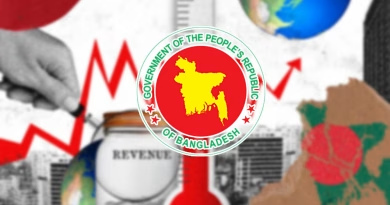Transparency has become the buzzword in modern governance, but its importance goes beyond politics and corporate boardrooms. In the banking sector, transparency is not merely a desirable trait—it is a necessity. Without it, trust erodes, risks multiply, and the financial system becomes vulnerable to crises. In Bangladesh, where the banking sector faces persistent challenges such as rising default loans, weak governance, and political interference, the question arises: is transparent banking a distant dream or a realistic possibility?
Why Transparency Matters
Banks are custodians of public wealth. Every depositor entrusts their hard-earned money to banks with the expectation that it will be managed safely and responsibly. Transparency ensures that this trust is justified. It allows stakeholders—customers, regulators, investors, and the public—to understand how decisions are made, how risks are managed, and whether funds are used ethically. When transparency exists, accountability follows. Managers and board members know that their actions are visible and subject to scrutiny, reducing the likelihood of corruption, mismanagement, or favouritism. In contrast, opaque banking systems encourage reckless lending, insider deals, and political manipulation, creating a fertile ground for crises.
The Current Reality in Bangladesh
Unfortunately, transparency in Bangladesh’s banking sector remains limited. Official reports often understate non-performing loans, while political connections influence lending decisions. Public disclosure of major loans, boardroom decisions, and risk assessments is minimal.
Even when banks release annual reports, they are often technical,
complex, and difficult for the general public to interpret.
State-owned banks, in particular, are vulnerable. Political
considerations sometimes outweigh professional judgment in loan
approvals, appointments, and governance decisions. This opacity has consequences. Non-performing loans accumulate, governance failures persist, and depositors’ confidence erodes. The cycle of secrecy and mistrust becomes self-reinforcing.
The Human Cost
The lack of transparency is not just an abstract problem; it affects
ordinary citizens directly. When banks fail to disclose risk
adequately or mismanage funds, depositors’ savings are endangered.
Entrepreneurs face difficulties accessing credit, not because their
projects lack merit, but because opaque practices favour politically
connected borrowers. Taxpayers often end up footing the bill for
recapitalization or bailout of troubled banks. In short, opacity in
banking has really economic and social consequences.
Lessons from Abroad
Global experience shows that transparent banking is achievable, but it requires commitment, regulation, and cultural change. Countries like Singapore, South Korea, and Canada have developed frameworks where banks operate under strict disclosure requirements, and regulators actively monitor risk. Publicly available information on loans, risk exposure, and corporate governance helps markets make informed decisions.
In South Korea during the 1990s Asian financial crisis,
transparency reforms were central to stabilizing the banking system. Problematic banks were restructured openly, non-performing loans were reported honestly, and political interference was curtailed. This allowed investors and the public to trust the system again, facilitating economic recovery.
Steps Toward Transparency
Bangladesh can learn from these experiences. Transparency does not happen overnight, but a combination of regulatory reforms,
institutional culture change, and public accountability can make it a
reality:
- Mandatory Disclosure: Banks should publicly disclose major loans, risk exposures, and board decisions. This should not be buried in lengthy reports but summarized in clear, accessible language.
2.Independent Oversight: Regulators must have the authority and
independence to monitor, audit, and act on malpractice without
political pressure. Central bank audits and independent supervisory
boards are crucial. - Digital Platforms: Technology can facilitate
transparency. Online dashboards showing bank performance, lending trends, and financial health can make information accessible to the public. - Whistle-blower Protection: Employees who report malpractice
should be protected. This encourages internal accountability and
strengthens the ethical culture. - Public Engagement: Customers and
civil society organizations should be encouraged to monitor banks
actively. Public scrutiny, combined with regulatory oversight, is a
powerful deterrent against mismanagement.
Overcoming Challenges
Transparency efforts are often resisted. Bank managers may fear that too much disclosure will create panic or invite criticism. Politically connected actors may see it as a threat to their influence.
Implementing reforms requires courage, political will, and the support of civil society. However, the long-term benefits far outweigh the short-term discomfort. A transparent banking sector reduces corruption, lowers risk, and increases efficiency. It strengthens public confidence, encourages investment, and promotes financial inclusion. In essence, transparency is the foundation of sustainable economic growth.
From Dream to Reality
Is transparent banking a dream or a reality? In Bangladesh today, it remains more of a dream than a reality—but it is attainable. The
tools, knowledge, and global examples exist. What is needed is
commitment from policymakers, regulators, bank leadership, and the public. Every step toward openness, from better reporting to
independent oversight, is a step toward a stronger, more resilient
banking system. The stakes are high. Without transparency, banks
remain vulnerable to crises, depositors remain at risk, and public
trust erodes. With transparency, banks can become engines of economic growth, supporting entrepreneurs, businesses, and citizens alike. The choice is clear: transparency is not just desirable; it is essential.
Conclusion
Transparent banking is more than an ideal—it is a necessity for
economic stability, public trust, and long-term growth. Bangladesh’s banking sector faces significant challenges, but these are not insurmountable. By embracing disclosure, accountability, and ethical governance, banks can transform from opaque institutions into trusted pillars of the economy. The dream of transparent banking is achievable—but only if stakeholders act decisively today. Without it, the banking sector risks stagnation, inefficiency, and repeated crises. With it, the sector can become a model of integrity, efficiency, and public confidence. The choice is ours, and the time to act is now.
The writer holds an M.Phil. degree from the University of Dhaka on
“Challenges of Digital Governance in the Financial Sector in
Bangladesh” and is currently a Ph.D. researcher. He is serving as an Evaluation and Documentation Officer at the Faculty Relationship Wing, Director General’s Secretariat, Bangladesh Institute of Bank
Management (BIBM), Mirpur-2, Dhaka.
anwar@bibm.org.bd. Xposure7@gmail.com. 01711732929
M.Phil Scholar of Dhaka University:
http://reposit.library.du.ac.bd:8080/xmlui/handle/123456789/4698






